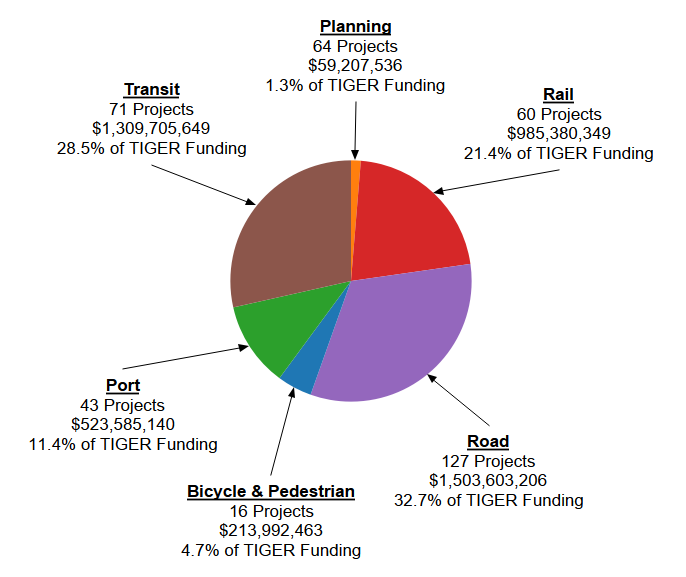The Transportation Investment Generating Economic Recovery, or TIGER Discretionary Grant program, provides a unique opportunity for the DOT to invest in road, rail, transit and port projects that promise to achieve national objectives. Since 2009, Congress has dedicated nearly $4.6 billion for seven rounds of TIGER to fund projects that have a significant impact on the Nation, a region or a metropolitan area. The graph below provides a breakdown of all awarded projects by type:

In each round of TIGER, DOT receives hundreds of applications to build and repair critical pieces of our freight and passenger transportation networks. The TIGER program enables DOT to examine these projects on their merits to help ensure that taxpayers are getting the highest value for every dollar invested through TIGER Discretionary Grants. Applicants must detail the benefits their project would deliver for five long-term outcomes: safety, economic competitiveness, state of good repair, quality of life and environmental sustainability. DOT also evaluates projects on innovation, partnerships, project readiness, benefit cost analysis, and cost share.
The eligibility requirements of TIGER allow project sponsors at the State and local levels to obtain funding for multi-modal, multi-jurisdictional projects that are more difficult to support through traditional DOT programs. TIGER can fund port and freight rail projects, for example, which play a critical role in our ability to move freight, but have limited sources of Federal funds. TIGER can provide capital funding directly to any public entity, including municipalities, counties, port authorities, tribal governments, MPOs, or others in contrast to traditional Federal programs which provide funding to very specific groups of applicants (mostly State DOTs and transit agencies). This flexibility allows TIGER and our traditional partners at the State and local levels to work directly with a host of entities that own, operate and maintain much of our transportation infrastructure, but otherwise cannot turn to the Federal government for support.
By running a competitive process, DOT is able to reward applicants that exceed eligibility criteria and demonstrate a level of commitment that surpasses their peers. While TIGER can fund projects that have a local match as low as twenty percent of the total project costs, TIGER projects have historically achieved, on average, co-investment of 3.5 dollars (including other Federal, State, local, private and philanthropic funds) for every TIGER dollar invested.
Program Background
Launched in 2009, TIGER's highly competitive process, galvanized by tremendous applicant interest, allowed DOT to fund 51 innovative capital projects in TIGER I and an additional 42 capital projects in TIGER II. TIGER II also featured a new Planning Grant category through which 33 planning projects were also funded. In TIGER III, DOT awarded 46 capital projects in 33 states and Puerto Rico. In TIGER IV, DOT awarded 47 capital projects in 34 states and the District of Columbia. TIGER V saw 52 capital projects in 37 states. Last year, TIGER VI awarded 41 capital projects and 31 planning projects in 46 states and the District of Columbia, and this year, in the most recently completed round of TIGER, TIGER VII was able to award 39 capital projects in 33 states.
Congress has dedicated nearly $4.6 billion to the program since its launch to fund projects that have a significant impact on the Nation, a region, or a metropolitan area: $1.5 billion for TIGER I, $600 million for TIGER II, $527 million for TIGER III, $500 million for TIGER IV, $474 million for TIGER V, $600 million for TIGER VI, and $500 million for TIGER VII.
The TIGER program enables DOT to use a rigorous merit-based process to select projects with exceptional benefits, explore ways to deliver projects faster and save on construction costs, and make needed investments in our Nation's infrastructure that make communities more livable and sustainable.

